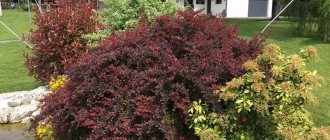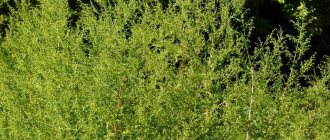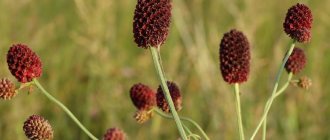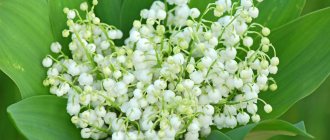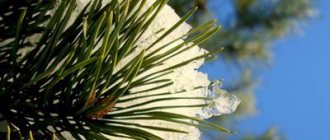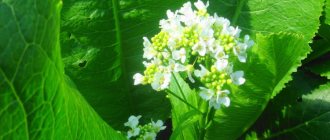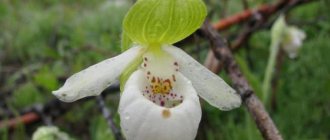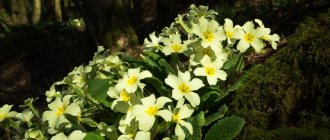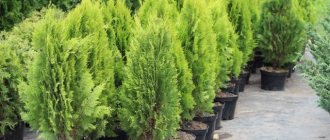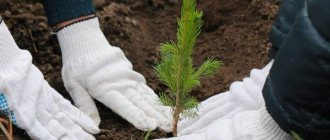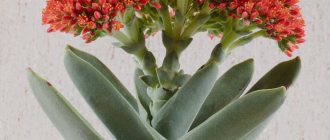Origin of conifers
Conifers or pinopsids are the oldest group of gymnosperms. Their first representatives grew in the northern latitudes of the planet 370 million years ago. This was the age of dinosaurs, the late Carboniferous period of the Paleozoic era. Later, it was these representatives of the flora that played the main role in increasing the cover of vegetation in the northern hemisphere.
Around 185-66 million years ago, pinopsids occupied large areas and were highly diverse. This period can be considered the starting point for modern conifers.
Approximately 66-2.5 million years ago, the oldest species could be found everywhere, including Antarctica and Greenland, beyond the tree line.
Interesting fact : conifers hold the following plant world records. The maximum height is evergreen sequoia (115.2 m), crown thickness is Mexican taxodium (11.42 m in diameter), age is long-lived pine (4700 years).
Description
The vast majority of conifers are perennials and evergreens. Only a few of them shed their needles for the winter. The rest renew their needles gradually, every few years.
Features of conifers:
- leaves are modified into needles;
- wood and bark contain many resinous substances;
- in the wild they grow up to 100 m or more;
- the formation of seeds covered with scales occurs in cones;
- Most of them are long-lived.
Root
The roots of the Siberian cedar pine
Conifers have a branched root system consisting of a long primary (tap) root with shoots in different directions and multiple short, branched roots. The latter are absorbent organs. Evergreen trees develop a taproot to great depths; it lies deep in the ground, up to two meters, which allows the species to survive in conditions of prolonged drought.
Foliage
Conifer needles
Conifers have a predominant needle shape. There are breeds with wide leaves in the form of stripes or scales. Their arrangement on the branch is mostly spiral-shaped, rarely opposite. They stretch from 2 mm to 400 mm in length. Trees growing in low light have darker needles. In blue spruce they have a matte-waxy coating, which protects the tree from ultraviolet radiation. Modified leaves retain moisture well and do not allow it to evaporate during drought, allowing sunlight to penetrate and absorb heat.
Reproduction
Pine cones
Coniferous trees mainly reproduce by seeds. Their difference from angiosperms is the absence of flowers and inflorescences, pistils and stamens. In spring, two types of cones are formed on the branches of the tree: male cones are microstrobiles, female cones are megastrobiles.
The cone consists of an axis and scales attached to it. On each cell of the megastrobilus, located at the top of the branches, two ovules with eggs inside ripen. Pollen ripens in greenish-yellow microstrobili. Then, with the help of the wind, animals or birds, it is transferred to the megastrobiles. The cone is glued together with resin, and the process of seed ripening begins. Two years later she falls to the ground. The seeds scatter on the ground and begin to germinate.
Interesting: How is wind speed measured?
Cedar
According to the botanical description, coniferous trees of the Cedar genus have only 4 species:
- Atlas;
- Cyprus (short-coniferous);
- Himalayan;
- Lebanese.
The evergreen Siberian cedar, which is widespread in Western and Eastern Siberia, the Urals, Mongolia and Northern China, is a representative of the genus Pine and is called Siberian cedar pine. The seeds of this particular plant (“pine nuts”) are eaten, since the seeds of true cedars are small and inedible. And it is the varieties of Siberian cedar that are most often grown in gardens and summer cottages.
Related article:
Evergreen cypress in the garden: photos and views, planting and care
Trees of this type look great in various variations of landscape design. They have a beautiful spreading dense dark green oval-shaped crown. And during fruiting, young yellow male cones are formed, which become an additional decoration of the branches.
Under natural conditions, fruiting of the Siberian cedar occurs at 35-40 years of age. However, in the garden, with proper care, you can get the first pine nuts in just 15-20 years.
Siberian cedar should be grown on sandy or loamy fertile soils. It does not tolerate drought, so it is important for it to provide regular watering. It is also sensitive to gas and dust in the air, so it is better to plant it outside the countryside. The following varieties can be used for garden plots:
| Name | Mature plant height | Needle color | Peculiarities |
| European cedar pine | 15-20 m | Green-blue | It grows very slowly (annual growth is 10-15 cm). Maintains the slimness and symmetry of the crown for a long time |
| Armandii | up to 20 m | Green-blue and green-yellow | The plant requires formation. In adulthood there is good drought resistance |
Related article:
Ideal conifers for a summer cottage: 6 best varieties of decorative spruce
Where do they grow?
Map of the distribution of pine trees
Evergreen species can be found on all continents of the planet:
- from the Equator, right up to the boundaries of permafrost;
- on the Eurasian continent;
- in Central and South America;
- some species are endemic to Africa and the tropics.
Coniferous forests grow best where winters are long and the climate is cold, with average to high annual rainfall. Moist soil is necessary for their life. Some representatives are found even beyond the Arctic Circle. In warm latitudes, these trees predominate in mountainous areas where there is no intense heat.
For the most part, pinopsids grow along the Pacific Ocean. Scientists believe that after the Mesozoic era, when these plants reached their highest development, the climate in these areas changed very little.
Interesting fact : scientists consider extinct fern-like ancestors of gymnosperms, and their first representatives date back to the late Devonian period.
Rules for planting and growing conifers
For the successful growth of coniferous plants, you need to adhere to some fairly simple rules of care and maintenance according to the requirements of your climate.
- Choose a shaded area (especially for dwarf species), especially during the lunch period, with shelter from strong winds.
- Buy plants based on your climate zones, otherwise they will die in winter.
- Purchase only from high-quality specialized nurseries, where the plant has been acclimatized and treated against pests and insects.
- The root collar should be on the surface of the soil during transplantation.
- For better rooting, plant young seedlings in early spring rather than late autumn. Before the onset of cold weather, they will get stronger and survive the winter safely.
- All coniferous plants prefer loose and moist soil with good drainage. Heavy clay soils are not suitable.
- Do not plant bushes too close, maintain a distance of 2 m.
- The younger the plant, the more watering it needs. Adults with sufficiently developed roots and crowns can survive for 2-3 weeks without watering.
- In harsh climatic conditions, where the temperature in winter drops significantly below 0, the roots are covered with spruce branches, even frost-resistant ones, otherwise they can easily freeze when they are on top.
Pine
The largest genera of the family are fir, larch, spruce and pine. Among them there are both evergreen and deciduous plants.
Dwarf
Gnome
This is a small Mediterranean pine tree in the shape of a ball. Thick green needles grow in the form of sharp needles that grow from resinous buds. Oval dark brown cones look like vertical candles. The plants are hardy, not afraid of frost, but do not like drought.
Pug
Pug
This tree, similar to an ellipse, grows almost equally in height and breadth. Resistant to frost and wind, content with a small amount of water. The pug grows slowly, reaching one and a half meters in height, adding 2-4 cm per year. It is not very picky about the soil and reacts poorly to air pollution. Changes needles once every 3-5 years.
Ophir
Ophir
is a dwarf tree whose trunk reaches a height of 50 cm. It has a good ability to grow in breadth. The crown of the ophir resembles a pillow in shape, but over time it becomes like a cone, expanding from below. The shrub's needles are hard and sharp, arranged in bunches, 3 cm long. Their color changes depending on the time of year: from bright green in summer to yellow in autumn. Ophir is unpretentious, resistant to frost and irregular watering. Exudes a special aroma caused by the release of essential oils.
Interesting: Diversity of wildlife - kingdoms, species, description, photos and videos
yellow pine
Yellow pine
Yellow pine is also called Oregon pine due to its widespread habitat - rocky mountains 1400-2600 m high, located in Oregon (North America). The needles and bark may be yellow, brown or reddish in color. Oregon pine is distinguished by its ability to prevent the spread of forest fires. Pine can grow up to 80 m, while the width of its crown can be up to 8 m.
Cedar pine
Cedar pine
This type of pine is called the king of the taiga zone. Under favorable conditions, a tree can survive up to 800 years. It grows up to 45 m in height, and the diameter of the cedar pine trunk can be two meters. In young breeds, the trunk is thin and the crown resembles a pyramid; in adults, the trunk is strong and has branches scattered on the sides. The tree is famous for its lush dark green needles with a blue tint and soft needles. The distribution zone of Siberian cedar is the Northern Urals, Siberia and the Far East.
Interesting fact : the growing season of cedar pine is only one and a half months a year. The rest of the period the tree remains dormant, which is why it lives to such an old age.
Whitebark pine
Whitebark pine
A frost-resistant and light-loving conifer (another name is “Geldreich’s pine”) has a small height (3-3.5 m) and diameter (2 m). The cone-shaped crown is made up of dense branches with hard, shiny needles. The pine tree is distinguished by a powerful, well-branched root that grows deep into the ground.
Interesting fact : the oldest representative of the whitebark pine species grows in Bulgaria. The ancient record holder is already 1300 years old.
Weymouth pine (American)
Weymouth pine (American)
The famous English explorer Weymouth at the beginning of the 18th century brought pine from America to Europe, which is now named after him. The second name of the tree is white. In North America, the habitat of this conifer is moist loamy and sandy soils, but sometimes it climbs high into the mountains. There, at an altitude of 1.5 thousand meters, a British officer discovered the tree.
In nature, these specimens live up to 400 years. Capable of growing up to 70 m, having a diameter of up to 1.8 m. The tree trunk is well branched, the crown has the shape of a cone.
Edel
Edel
A small shrub in the shape of a ball, over the years it takes on the appearance of a pillow and grows very slowly. In adulthood, it has a height of 0.8-1 m. It has silver-green needles with thin and delicate needles that make up individual bunches. Young plants already have cones. Edel does not like either dry or overly wet and saline soil. Withstands severe frosts well, prefers partial shade, does not like heat. It is not uncommon for it to be burned by spring sun rays. Edel's homeland is North America, where the breed can grow up to 60-70 m. The crown takes the shape of a pyramid. Among pine trees, one of the fastest growing plants.
Oil pine
Butter Pine
The Weymouth Butter Pine is amazingly beautiful and has the shape of a ball. Its silvery-green needles consist of so-called “little curls” - curved needles. This makes the plant seem thick and fluffy. Tiny Curls are a dwarf variety of Weymouth, growing to approximately 100cm in height.
Norway spruce
Common
spruce Coniferous forests stretch all the way to the Urals, where common spruce grows very abundantly. Its homeland is Europe. This plant is 20-30 m tall, the trunk is 1 m in diameter, and the cone-shaped crown, which remains sharp until the end of its life, is 6-10 m. The gray layered bark is usually covered with deep cracks. The short dark needles are hard and sharp; the cones, which ripen in winter, are up to 15-17 cm long; in young breeds they have a purple tint, then turn brown. Spruce trees live from 200 to 400 years both in the mountains and in marshy soils.
Interesting: What shape do raindrops have?
Siberian spruce
Siberian spruce
A tall (up to 20-30m) tree with a straight, pyramid-shaped trunk, it lives in Western and Eastern Siberia, where frosts below -45 degrees are not uncommon. Easily withstands very low temperatures. The gray bark is covered with cracks. Depending on the subtypes, the needles may have green, bluish-blue, silver or golden color. Cones in the form of a cylinder or oval, brown in color. Often forms hybrids with common spruce.
Serbian spruce
Serbian spruce
This endemic species of spruce was discovered by the Serbian scientist Pancic (its second name is “Pancic spruce”) in the second half of the 19th century. The tree grows in a small area of 60 hectares in the Drina River valley. It stretches upward very quickly, reaching a height of up to 40 m. The brown-violet cones look elegant against the background of the bluish-green crown. They are 4-7 cm long and resemble a spindle. After ripening they acquire a dark brown color.
Silver spruce
Silver spruce
A very slender, beautiful and unpretentious plant with a spire-like crown, in the wild it grows both in small groups and alone. It is resistant to frost, polluted air, and snowdrifts. Silver spruce chooses places along rivers, the northern slopes of mountains, and is found at an altitude of 2000-3000 m above sea level. The tree grows up to 50 m, developing a crown up to a meter in diameter.
The sharp but not hard needles have 4 sides and grow in different directions. Its color is bluish-green, there are two silver stripes on the bottom and top of the needles (hence the name). The lower branches lie on the ground, and yellow and purple-brown seed cones hang from the upper branches. The bark is covered with gray scales.
Fir
Fir
Tall cone-shaped firs, reminiscent of spruce in appearance, do not like severe frosts, high temperatures and lack of moisture. They are light-loving, but can also grow in shaded areas. In the wild they live for a very long time - up to 400-700 years. The column-shaped trunk is covered with a dense crown, which over the years takes on the shape of a cylinder. Fir sheds its needles every 8-10 years. In the fourth decade, the tree begins to bear its first fruits.
Caucasian Nordmann fir
Caucasian Nordmann fir
This type of conifer often decorates New Year's holidays in homes and city squares. It is popular for parks and gardens as an ornamental tree, although it grows at a slow pace. The Caucasian beauty rushes up to 60 m (sometimes up to 70-80 m), having a trunk diameter of up to 2 m. It is one of the tallest trees in Europe.
Silver fir
Silver fir
High in the mountains of North America, along the Pacific coast, lives the slender, cone-shaped silver fir (another name is “noble”). Being young, it grows slowly, but the trunk of an adult tree begins to quickly stretch and can reach 80 m in height with a diameter of 2 m 20 cm. It loves moisture and warmth, but is not resistant to frost.
Its wood is durable and in great demand. Cones - microstrobiles occupy the lower part of the tree, while megastrobiles are located on the uppermost branches.
Korean fir
Korean fir
Even in summer, it seems that the branches of this pine species are covered with white snow. This is because the inside of the needles is covered with silvery veins, which are visible due to the curved ends of the needles. Fir lives in coniferous and mixed forests, on mountain slopes. The plant is distinguished by the fact that it grows in breadth, while it is in no hurry to stretch upward. In young species the bark is light and smooth, but with age it darkens and cracks. Blue cones up to 7-8 cm in length, cylindrical in shape and with a purple tint. They look elegant on the emerald-silver lush crown.
Interesting: Why does picked unripe fruit ripen?
Balsam fir
Balsam fir
grows well in shaded areas, but also loves the sun and good lighting. Prefers moisture and good soil and grows up to 25 m in height. The crown resembles a regular cone, the branches grow all the way to the ground. The needles are not hard, with a special shine, the ends of the needles are blunt. The tree exudes a special aroma of resin. Shallow roots are concentrated near the surface of the earth. Due to this, the tree is not wind-resistant. It grows in areas with cool climates and lives a long time (up to 300 years).
Larch
Larch
Unlike other coniferous species, this tree sheds its leaves in the fall and, remaining in a dress of graceful round cones, feels great in winter frosts. The larch trunk is thicker than that of its closest relatives, almost a meter in diameter. The crown of a young larch is cone-shaped, in adulthood it becomes similar to the shape of an egg. Under favorable conditions, it lives a long time, from 300 to 800 years. Does not tolerate shadows. The habitat is Western and Northern Europe, the Carpathians.
Interesting fact : such architectural landmarks of St. Petersburg as the Winter Palace and St. Isaac's Cathedral were built on piles of high-strength larch.
Hemlock
Hemlock
Carl Linnaeus classified the hemlock coniferous tree, native to eastern North America, in the 18th century. It thrives in the shade and loves moisture and acidified soil. It is a 30-meter tall cone-shaped plant with reddish scaly bark. Male cones are yellow and female cones are light green. Paper and furniture are made from this rock.
Ketelery
Keteleeria
Some species of Keteleeria live in the wild for up to 1200 years. The habitat of these trees is considered to be China and the island of Taiwan. The plant is named after the Belgian gardener Keteleer, who isolated it only in the second half of the 19th century. This is a monoecious plant, the microstrobiles are covered with needles at the ends, the megastrobiles have axils. The ovoid cones ripen in December. Whorled branches of trees are located on the trunk at different distances from each other.
Spruce
Spruce, like pine, belongs to the Pine family. This is a powerful plant, which in the first years of life actively stretches upward, and the side shoots on the trunk are placed at large intervals. Therefore, the crown appears sparse. However, soon the trunk begins to be densely overgrown with whorled branches, on which short tetrahedral or flat needles grow.
Spruce is shade-tolerant, frost-resistant, and not demanding on soil. It will do well on poor soils, but prefers sandstones and loams. Loves moisture, however, does not tolerate stagnation of water. Therefore, when planting, it is necessary to ensure high-quality drainage and regularly loosen the soil around the trunk.
Related article:
How to trim thuja correctly
Types of spruce such as European (Common) and Blue spruce are very popular. However, under natural conditions their height can reach 30-50 m, which would be inappropriate for a small area. Therefore, for the garden you should use their dwarf and low-growing varieties:
| Name | Mature tree size | Needle color | Peculiarities |
| Barry | 2 m | Dark green, glossy | When young, the plant has a spherical shape. Over time, the crown becomes pyramidal |
| Nidiformis (Nest-shaped) | 1m | In spring – light green, in winter – emerald | Lush, slow-growing dwarf tree with a spherical crown and uneven branch growth |
| Topaz | 5 m | Blue | The lush crown looks like a perfectly regular cone |
| Royal Blue | 5 m | Silver blue | Royal Blue is often used in landscape design to create mixed compositions. The variety prefers well-lit areas. |
| Canadian spruce Konica | 3m | Emerald | Tree with soft needles. The variety does not tolerate compacted plantings and waterlogging |
| Picea abies Acrocona | 4 m | Emerald | Tree with red cones |
Related article:
Thuja turned yellow after winter - what to do, how to help the plant, video
Cypress
The cypress family includes several dozen species of heat-loving evergreens. Being ancient relict species, they prefer tropical and subtropical climates to live.
Thuja
Thuja
This tree is also called the Life Tree. Thuja can grow up to 70 m in height and up to 6 m in width. The needles of young trees are soft and become scaly over the years. The shape of the crown varies among different species: spherical, rectangular, pear-shaped, creeping, horizontal.
Thuja bears fruit annually and produces a rich harvest every 2-3 years. This is a monoecious plant, the cones are oval or oblong, covered with 2-6 pairs of scales.
Juniper polycarp
Juniper prolifica
A squat shrub with a dense reddish or red-gray crown. Short branches with black and blue fruits. The dioecious plant lives up to 200 years. Situated in groups or alone. Tolerates drought and rocky soil well. This species is widespread in Central Asia, Pakistan, and Afghanistan.
Cryptomeria
Cryptomeria
Other names are “Japanese cedar” (not actually a cedar), “sugu” and “shan”, the only representative of the genus Cryptomeria in the cypress family. It grows in Japan and China in areas with a warm and humid climate. It has a straight cylindrical trunk up to 2 m in diameter and a beautiful pyramidal crown. The needles are light green in color and are arranged in a spiral on the branch. The wood is light and practically not subject to rotting.
Interesting: What is pollen for? Photo and video
Red cedar
Virgin Juniper
A coniferous species native to North America has the international name Juniperus virginiana. It has a powerful root system with numerous branches. The needles are scaly, with a specific smell. Juniper grows quickly and loves bright places. The shrub has low soil requirements and is resistant to wind and rot. In the natural environment it can live up to 500 years.
Juniper squamosus
Scaly juniper
The species' range includes the mountainous regions of China, Taiwan, and the Eastern Himalayas. A frost-resistant and light-loving plant, it is a shrub with dense branches and needles, 0.5-0.8 cm long. The crown is dome-shaped. Black shiny fruits - cones ripen the next year. Growth is up to 1.3-1.5 m in height. Not afraid of drought and rot. It takes root well on any soil.
Cypress evergreen
Evergreen cypress A
woody plant 25-30 m in height with dark green soft needles, grows in Europe and Asia, in the Crimea and the Caucasus. Small round cones are covered with scales that look like patterns. The tree grows quickly, on almost any soil, is resistant to drought, is not afraid of shade and a short drop in temperature to -20 degrees. The genus of cypress trees belongs to ancient plants, some of them can live up to 2000-3000 years.
Interesting fact : insects are repelled by the specific smell of cypress, so they are not found where it is present. By placing a cypress branch in a closet with clothes, you can get rid of moths.
Cypress
Cypress
Translated from Greek, cypress means “cypress on the ground.” This monoecious coniferous plant is a cross between cypress and thuja. Young representatives have needles in the form of needles, while older ones have scaly ones. Woody cones grow at the ends of the branches, smaller in size than those of cypress. The tree can grow up to 70 m.
Kallitris
Callitris
This is a tree with scaly needles arranged in rows of three. The height of the plants is from 5 to 25 m. They resemble a ball or an egg in shape. At the ends of the branches, ovoid or round cones of different sexes appear: male, small, 3-6 mm, and female, larger, up to 1-3 cm in length and width. They take about a year and a half to mature. They can remain closed for a very long time until there is a fire in the forest. The cones open, and the seeds scatter on the scorched earth and germinate.
Pine
Pine is an evergreen, resin-rich coniferous tree (shrub or dwarf) of the Pinaceae family. Most often it grows in the Northern Hemisphere, so it is found in almost every corner of Russia. Pine is undemanding to soil, frost- and drought-resistant, and is not particularly difficult to care for.
In the garden you can grow “forest” varieties of pine or use seedlings grown in specialized nurseries. The second option will be more rational, since in this case you can choose low-growing varieties that will have an attractive appearance and will not take up much space on the site. These include:
Related article:
We save thuja from yellowing with fertilizing
| Name | Mature plant height | Diameter | Needle color | Peculiarities |
| Mugus | 1m | 2 m | Dark green | Young cones are purple, mature seeds are edible |
| Black pine Hornibrookiana | 2 m | 2 m | Light green | Used to strengthen slopes or as a hedge. Crown shape – spherical |
| Oregon Green | 4-6 m | 4 m | Dark green | A young seedling is protected from sunburn in early spring. |
| Ophir | 1m | 1.5 m | In summer – green, in winter – bright yellow | The crown at a young age has a regular spherical shape, becoming spreading over time |
Pine grows relatively quickly, especially in the first 10 years of life. For planting, 5-7 year old seedlings are usually used, which should be planted in a well-lit area. The lack of sunlight does not have the best effect on the appearance of the coniferous plant: the shoots become elongated and the needles become pale in color. Despite fairly good winter hardiness in cold climates, young seedlings will need shelter in the first two years after transplanting into the ground.
Related article:
Low spruce trees for the garden
An important event in the process of growing pine is the formation of the crown. The procedure is performed in the spring, around May, when young “candles” grow on the shoots. Pinch the shoots by about 1/3 or ½ manually, without using pruners, using twisting movements. The tool is used only if it is necessary to completely remove the branch. With regular formation, the pine crown becomes fluffier and takes on a neat outline.
Yew
The leaves of this species are hard, linear or lanceolate, with narrow or wide needles. For the most part, trees remain green all year round, but there are, although very rarely, species that lose leaves in winter.
Interesting fact : yew needles are dangerous for animals, as they cause poisoning.
Yew berry
Yew berry
A very elegant evergreen plant, sometimes reaching 40 m in height, has healing properties. At the same time, it is poisonous. It grows slowly, but its life expectancy is high - several thousand years. A lush, dense bush in shape resembles a cylinder or pyramid. The bark is smooth, red-gray. Flat dark green needles 20-35 mm long are arranged in a spiral. The strong branched root allows the yew to grow in any type of soil. It reproduces by seeds, which are spread by birds eating the berries of the bush.
Interesting: Tsunami: what is it, causes, types, consequences, photos and videos
Torreya
Torrey
The genus of the yew family is named after the American flora researcher John Torrey. It is a small tree, usually 5-20 m in height. The spiral-shaped needles are rigid, with pointed ends. The plant can be either monoecious or dioecious. Female cones mature in a year and a half. The only large seed looks like a nut.
The needles, stems, and cones emit a very unpleasant aroma. The range of torrea is East Asia and North America.
Fir
Fir, like spruce and pine, is another representative of the Pine family. This is a powerful, long-lived tree with an even trunk and a pyramidal crown. The characteristic features of fir, which allow it to be distinguished from other pine trees, are flat needles and cones growing upward (reminiscent of candles on a Christmas tree).
Most types of fir are heat-loving, shade-tolerant, but do not tolerate heavy frosts. Therefore, when choosing a variety, you should pay attention to the degree of frost resistance of the plant, which is usually indicated in the accompanying documents (if the fir was purchased from a nursery).
During the first few years, the tree grows very slowly, so for planting in the garden, preference should be given to 5-year-old seedlings. The soil on the site should be fertile and well-drained, without stagnant water. When young, firs require periodic watering using several buckets of water (depending on the size of the seedling). An adult fir does not need watering. Also, she does not need crown shaping.
Related article:
Popular varieties of low-growing blue spruce
Among the most popular coniferous plants of this species are the following:
| Name | Mature plant height | Needle color | Peculiarities |
| Korean fir (Abies koreana) | 10 m | Dark green | When ripe, the buds are purple or bluish-purple |
| Balsamic | 20 m | Emerald | High frost resistance. Purple-violet buds |
| Unicolor Violacea | 15 m | Blue | Lush pyramidal crown with branches growing parallel to the ground |
| Nana | 50 cm | Dark green | An evergreen shrub with a spreading crown. Shade-tolerant, frost-resistant, grows slowly |
Araucariaceae
Araucariaceae are tall trees of the Southern Hemisphere. These ancient plants were widespread throughout the planet during the Jurassic and Cretaceous periods. Later they left the territories of the Northern Hemisphere.
Agathis
Agathis
In New Zealand, a large (up to 80 m) coniferous plant grows, with lush, spreading branches, large round cones (15 cm in diameter) and soft long (up to 18 cm) leaves. The tree has elastic, high-quality wood, which is very valuable when processing. The gray-brown bark is smooth, almost without knots. The branches grow horizontally, eventually hanging down. Fresh ovate orange leaves look very nice with old green elliptical foliage.
Araucaria
Araucaria
Araucaria gets its name from the province of Arauco, located in Chile. These flat-coniferous giants with hard, needle-like leaves have a strong, straight trunk up to 30-80 m high. Being dioecious, the plants are able to change sex throughout their lives. Female (round) cones, which grow in the upper part of the crown, and male (elongated) cones up to 20 cm long, weigh up to 1.5 kg. The seeds can be eaten.
Araucarias mostly grow in Australia, New Guinea, two species are found in America. The plant is grown as an ornamental in the Crimea and the Caucasus.
Sequoia
Sequoia
One of the largest trees in the world, reaching 60-100 m in height. Redwoods have existed since the age of dinosaurs. They are about 200 million years old. A special feature is that when there is a lack of moisture, they shed entire branches instead of needles. In very ancient times they grew abundantly in the northern hemisphere, but now there are only three species, and they are present in America and China. Their large trunk, tapering upward, has a diameter of 3-4.5 m. The bark is thick, hard, red-brown in color. Male cones in the shape of a ball or egg have a size of 2-5 mm, and female cones in the shape of an ellipse - 12-35 mm.
The influence of microclimate on coniferous plants
The position of the site and the position of the plant on the site seriously affect the survival of coniferous plants. In the gardens of professional collectors you can see well-developed magnolias a kilometer from the Moscow Ring Road, large yews and other vulnerable plants.
In the Botanical Garden of Moscow State University there is a huge Aristolochia and many other heat-loving plants. But this does not mean at all that they will feel just as good in another area near Moscow. Wind, proximity of buildings - especially if it is a permanent home, warmth, lighting, groundwater level - all this matters. You need to soberly assess your chances. In general, in the Moscow region, everything that belongs to zone 5 and above will not winter stably. If you still want to take a risk, then you need to be aware that such a coniferous plant should not be made a soloist, a key element of the composition. It can please you for a year, five years - until the next harsh winter, and then die. It is better to conduct such risky experiments in a less visible place.
If some “sissies”, including yews of the Chinese juniper variety, oriental spruce, grow safely and winter on your site in the middle zone - rejoice in your luck. If it is clear that such new settlers are depressed and do not want to grow and are freezing, try transplanting them to a more secluded place, protected from the wind or sun.
What coniferous trees are bought for the New Year?
Spruce is an indispensable attribute of the New Year's holiday.
New Year's holidays cannot be imagined without fragrant spruce, pine or fir. They decorate apartments with their presence and look great under the snow caps in large parks and squares.
Some people prefer spruce because of its low price and fragrant resin aroma. The cone-shaped crown of a tree with thick branches looks bright and festive when dressed up.
In a warm room, spruce quickly loses its fresh appearance and smell. The needles quickly begin to dry out and turn yellow. To somehow refresh the plant, you need to constantly spray and water it.
Pine is considered more resistant to home heat, but its price is higher. But for those who are attracted by the rich antimicrobial aroma, this conifer is just right. Pine is not as thick as spruce, but its needles are long and strong, so you can hang toys on them without fear. Its negative side is the release of sticky, difficult to wash off resin.
Fir will last the longest without losing its freshness. Due to the soft, non-thorny needles, dressing it up is a pleasure. The downside is the lack of pine smell and the high price.
Juniper
Juniper is an evergreen coniferous shrub (less often a tree) with a cone-shaped or ovoid crown. Its size varies depending on the variety. Most often, shrubs reach a height of 1-3 m. There are also small trees (8-10 m) and dwarf trees that rise 10-15 cm above the ground.
Related article:
What to do if the thuja turns red after winter
Juniper is easy to care for and very frost-resistant (withstands frosts down to -40C). It can be planted along alleys, on alpine crusts and in rockeries. However, it should be borne in mind that the plant does not tolerate waterlogging, so it does not need to be watered often.
Popular garden varieties of juniper include:
| Name | Mature plant height | Needle color | Peculiarities |
| Blue Arrow | 3m | Dark green | High growth rate |
| Old Gold | 1.5 m | Golden | Easy to care for. Has insecticidal properties |
| Hunnetorp | 1.5 m | Gray-blue | Spreading light-loving shrub with a diameter of 2.5 m, with prickly needles |
| Silver Star | 3m | Bluish with cream spots | Columnar juniper with a narrow, unthickened crown |
Juniper is known for many beneficial qualities and has strong phytoncidal properties, so it is classified as a medicinal crop. However, it can become a source of spread of such a dangerous fungal disease as rust in the garden. It is an intermediate “host” for fungal spores, which, after ripening, move on to fruit crops. Therefore, juniper should be planted away from fruit trees.
Related article:
How to prune Scots pine
